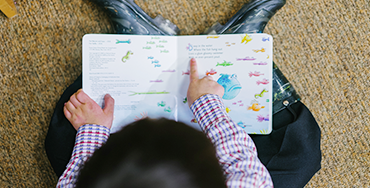Guided reading is an important approach in literacy education, adopted by primary educators in the US, UK, Australia and many other countries.
When used in-conjunction with other approaches (such as shared reading, reading aloud, and independent reading), it enables teachers to provide very effective scaffolding for student literacy learning.
Generally, the teacher works with a small group of 3 to 6 children, all of a similar reading level, for 15 to 20 minutes. The teacher will select a text which is generally slightly harder than one they can read without support. For book inspiration visit the Guided Reading Book Lists which suggests book titles for every level reader.
Often it helps to have a set of objectives in mind such as focusing on reading and recognizing sight words using picture cues, tracking print left to right, making predictions, activating prior knowledge, identifying story elements, sequencing or phonemic awareness.
The reading session might start with a before-reading activity such as asking pupils what they think about the cover, getting them to predict what’s inside and even inviting them to make connections to their own experiences and previous reading. Or the teacher might decide to take a ‘picture walk’ through the book, encouraging the children to discuss what they see in the pictures.
During-reading, depending on the group, the teacher may model read the text first, allowing students to follow along and point to each word as its narrated, after which the students read the text to themselves at their own pace. Other times the children will be asked to start by reading the text themselves – either out loud or silently with the teacher on-hand to provide immediate support as they go.
After reading the text, the teacher may conduct a mini-lesson focused on the objectives or skills selected for the lesson.
Whatever way the session is conducted, the important thing is that the teacher is providing an instructional approach, coaching the learners as they use problem-solving strategies to read the text. The ultimate goal is independent reading and fluency.
The Origins of Guided Reading
Although guided reading has taken place informally in schools over the past 50 years or so, today’s more structured approach has been largely formed as a result of Vygotsky’s (1978) Zone of Proximal Development and Bruner’s (1986) notion of scaffolding, which was informed by Vygotsky’s research.
The practice of guided reading is based on the belief that the optimal learning for a reader occurs when they are assisted by an educator to read and understand a text with clear but limited guidance. Guided reading allows students to practise and consolidate effective reading strategies.
Vygotsky was particularly interested in the ways in which children were challenged and extended in their learning by adults. He argued that the most successful learning occurs when children are guided by adults towards learning things that they could not attempt on their own.
Vygotsky coined the phrase 'Zone of Proximal Development' to refer to the zone where teachers and students work, as children move towards independence. This zone changes as teachers and students move past their present level of development towards new learning. (Source: Literacy Professional Learning Resource, Department of Education and Training, Victoria)
How to use your Clevertouch too support Guided Reading sessions
Clevertouch supports guided reading with a number of carefully selected education apps, that can be used in conjunction or alongside the the guided reading sessions.
Cupcake story apps and learn and play activity apps are available for free within the Cleverstore. They enable children to physically engage with the text using the touchscreen’s interactive features to complement the teachers scaffold approach to literacy learning.
Animal Planet Hide & Seek Pets
3 to 5 years

Explore animals and their traits whilst improving literacy and maths skills. Games include a puzzle, letter trace and memory match, also featuring a ‘learn’ and ‘grown-ups corner’ for comprehension questions.
RIO 2 (The Official App for the Movie)
5 to 7 years

Children may have already met Blu & Jewel, the lovable blue macaws, in the RIO movies. In this jungle adventure Blu, Jewel and their 3 children end up in the wilds of the Amazon where Blu tries to fit in and Jewel reunites with her family. Students can read the story and embark on a special journey in an interactive app experience full of colourful images and original fun-filled games.
Tree Fu Tom: Squizzle Quest
5 to 7 years

Tree Fu Tom is a popular character with Key Stage 1 children, and Story Mode is great on the big screen of the Clevertouch. Children or teachers can read the story aloud, or unclick the “mute” button and have the animated voice read. Teachers can pause to annotate at any time by using the Clevertouch Widget.
Wubbzy’s Fire Engine Adventure
3 to 5 years

Trouble at the Spaghetti and Meatball Factory sends meatballs raining down on Wuzzleburg! When the Fire Chief forklifts the oodles of noodles out of Wuzzleburg, Wubbzy’s decides he wants to help, too. After rescuing Earl with the ladder and filling the birdy birdbath with the hose, Wubbzy learns to leave the real emergencies to the firefighters. Filled with hilarious tap-and-play interactivity, Wubbzy’s Fire Engine Adventure gets kids revved up and ready to learn!
This entertaining app has three storytelling modes – each professionally narrated with Read To Me, Read & Play or try Just a Book for quiet reading time, sing-along music videos, colouring pages and surprising animations and interactions on every page bursting with playful sound effects to keep young students engaged.
